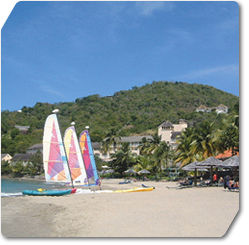- Villa search

- Canaries
- Caribbean
- Croatia, Bulgaria and Hungary
- Cyprus
- Florida
- France and Corsica
- Greece
- Italy
- Lakes and Mountains
- Madeira
- Malta and Gozo
- Portugal
- South Africa
- Spain - Balearics
Information
Country information: CountryName
Map of CountryName

For many people the landscape and natural attractions of St Lucia are matched by no other Caribbean island. And hearteningly, its enlightened government is protecting these assets.
For many people, the landscape and natural attractions of St Lucia are matched by no other Caribbean island. And hearteningly, its enlightened government is protecting these assets.
The most spectacular landscape has to include the unforgettable spires of the Pitons – a stunning sight from various vantage points on the island and from the sea. A variety of hikes and visits can be arranged but, at all times, explorers are reminded that the mountains are conservation areas and thus protected from harm to their ‘fragile environment’.
Inland, there is rainforest –19,000 acres of lushly-wooded mountains and valleys that are home to giant ferns, birds of paradise, exotic flowers and fruits, wild orchids and mushrooms.
If you’re lucky, you might glimpse the rare and vividly-coloured St Lucia parrot, or possibly the white-breasted thrasher, St Lucia peewee or St Lucia oriole.
Interspersed with the rainforest are little fields and orchards of papaya, mango, coconut and banana trees.
St Lucia also has a ‘drive-in’ volcano. You can have a very close look indeed at its sulphur springs – a steaming, bubbling reminder of the volcanic origins of this and the other mountainous Caribbean islands (the flatter ones, like the Bahamas and Barbados, are formed from coral).
Most of the island’s coral reefs and richly-diverse marine life are protected from the ravages of tourism. Water sports enthusiasts, snorkellers, scuba divers and boat owners can have a terrific time – but you need a permit to enter the reefs. The money raised is ploughed back into repair and further protection.
Back on land, the highest point is Mount Gimie (3,117 feet) – guided tours to the top are available. Or you may prefer to stay cool under the cascading waters of the Diamond Falls, where Louis XVIth built bath houses for his troops.
Besides its terrific natural beauty, St Lucia has some attractive architecture, good shopping, picturesque fishing villages, historic military installations, and excellent restaurants, many serving local specialities like pepperpot stew, callaloo and curry, and most of them having open air dining areas.The St Lucia government knows that tourism is at least as important as agriculture for future prosperity, and the infrastructure is being steadily improved to support this.
Unusually, a good deal of past tourism budgets has been spent on a brand-new, high-tech prison! It’s not much of a tourist attraction, but it is reassuring to know that the authorities are determined to keep the island law-abiding. There is a policy of zero-tolerance on drugs and, as a result, the associated crime is simply not there.
Another recent investment has been the impressive International Cricket Ground, which opened to great acclaim.
No island description can avoid mentioning the effects of history, particularly the era of colonialism. Two thousand years ago Arawak Indians settled here, but by 800 AD they’d been superseded by the Caribs who lived a carefree existence until the Europeans arrived.
The English, French and, at one point, the Dutch, all dabbled and squabbled, the two former countries slogging it out for around 150 years before the English finally ‘won’ control of the island in 1814.
It remained an English colony until independence in 1979 but there is still quite a strong French ambience, most notably in the place names (Vieux Fort, Soufrière) and the creole that is spoken. During much of the colonial period, slaves were brought to the island from Africa to work on sugar and cocoa plantations. Their descendants make up the largest proportion of the island’s population.
home | destinations and editorial | villa search | property for sale | car hire | flights | services
villaseek blog | contact villaseek | links and resources | advertise your villa© Dune Root Ltd and Villaseek.com 2012 - Caribbean
- Canaries